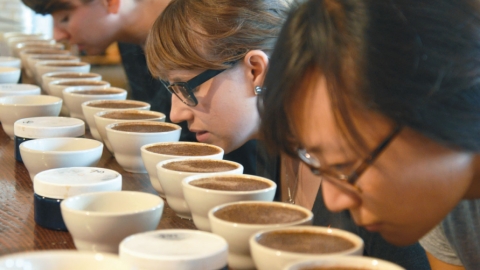Barefoot Coffee: Roasted in Santa Clara
To the general public, Barefoot might seem to keep a low profile, but they’ve been steadily building a loyal following since 2003 and are going strong. Specializing in wholesale bean sales and education, Barefoot roasts 2,500– 3,000 pounds of beans per week, keeping the Bay Area (including employees of Airbnb, Square and Google) well caffeinated. Barefoot also provides barista training, machine sales and support to cafés all over the region.
David Johnson started with Barefoot in 2007 in production (bagging beans) and apprenticed as a roaster before becoming green buyer and head roaster. He explains that “everyone at Barefoot starts out in production. We’re a small company; being versatile helps us jump around wherever we’re needed.”
Though many of Barefoot’s coffees qualify as direct trade, Johnson prefers the term “relationship coffee,” as he feels it more accurately describes the intimate relationships with growers he has cultivated over time. “You can see how they treat employees and how sustainable they really are. You can tell a healthy farm by looking at the leaf development on the trees.”
All the beans Barefoot roasts are hand-picked as they mature and each tree is harvested multiple times over a season. This is significantly more labor intensive, and expensive, than the more industrialized methods many other growers use. Barefoot pays 30%–40% above Fair Trade prices, and Johnson sees the impact. “Eight to 10 families live on these farms. They take care of them, send the kids to school, they employ an agronomist, they’re able to reinvest and give back to community, and as a result everyone is more successful.”
If you aren’t lucky enough to have Barefoot at your workplace, you can buy beans at many local markets (including Whole Foods), visit the Rollup Bar on Fridays and Saturdays or attend one of their classes or free public cuppings on the first Friday of every month, where you can meet the roaster, ask questions and learn about coffee.
“Your palate gets developed by time spent at the cupping table,” Johnson says.



